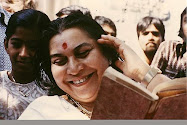"Today it's a different day, altogether, for all of you, because this is the Puja of Adi Shakti. And Adi Shakti is the Complete Personality. It's not only the left side that you know. You all know only the left side, from Shri Ganesha, through the ascent of different different Chakras on the left side. I didn't want to tell you about the right side, to begin with, because those who have gone through the right side just got lost. They got Gayatri Mantra from the writings. But they didn't know what it was about. They just used to learn it by heart. They didn't also know the real meaning of it, and that is how they moved on the right side, and, I don’t know, they landed up at the Agnya. And then they were trying for the Self Realisation. They were promised that if you do this right side properly, you will reach to the ultimate goal of Self Realisation. But none of them reached there. Most of them got into a terrible temper. Terrible temper, of cursing others, of destroying others, all these things they learnt, through their right side movement. There was no Kundalini awakening. And they were made to go up to, at the most, Agnya Chakra. And then they collapsed into different places of complete ignorance. All these books were written without understanding that it's not easy to go via right side. But best was, to awaken your Kundalini."
(H.H.Shri Mataji Nirmala Devi, Shri Adi Shakti Puja 2002)
The Gayatri Mantra is found, in Sanskrit, in the earliest part of the Rig Veda (iii,62,10):
Aum Bhur Bhuva Svah
Tat Savitur Varenyam
Bhargo Devasya Dhimahi
Dhiyo Yo Naha Prachodayat
and each syllable has a precise meaning.
There is also a longer form:
Aum Bhur, Aum Bhuva, Aum Svah,Aum Maha, Aum Janaha, Aum Tapaha, Aum Satyam, Aum Tat Savitur, Varenyam, Bhargo Devasya Dhimahi Dhiyo Yo Naha Prachodayat
and many variant forms.
29.3.08
Subscribe to:
Post Comments (Atom)

3 comments:
What is this Gayatri Mantra for? What did it say?
thanks for the comment.
I've added the text and a link to an English explanation of the meaning.
In the traditional Sahaja Yoga Mantra book the Gayatri Mantra is as follows:
OM Bhooh OM Bhuvah OM Swah Om Mah
OM Janah OM Tapah Om Satyam
OM Tatsavitruvarenyam Bhargo Devasya Dhi Mahi,
Dhiyoyonah Prachodayat Om Apo Jyotirasomritam,
Brahma Bhoor Bhuvah Swarom.
Another version sang on a Sahaja Yoga record by Anandita Basu is:
OM Bhooh OM Bhuvah OM Swah Om Mah
OM Janah OM Tapah Om Satyam OM Bhur Bhuvah Swah
OM Tatsavitruvarenyam Bhargo Devasya Dhi Mahi,
Dhiyoyonah Prachodayat Om Apo Jyotirasomritam,
Brahma Bhoor Bhuvah Swarom. OM
There is a short 'a' sound after Bhooh and Bhuvah and many more. So it could also be written as:
OM Bhooha OM Bhuvaha OM Swaha Om Maha
OM Janaha OM Tapaha Om Satyam OM Bhur Bhuvah Swaha
OM Tatsavitruvarenyam Bhargo Devasya Dhi Mahi,
Dhiyoyonah. Prachodayat. Om Apo Jyotirasomritam,
Brahma Bhoor Bhuvah Swarom. OM
The dot signifies a very short 'a' sound.
Post a Comment